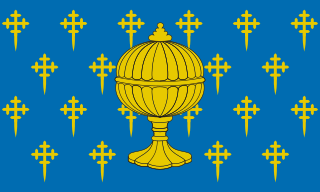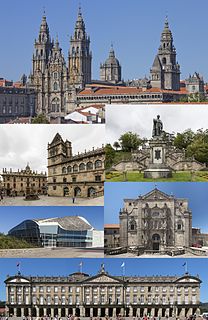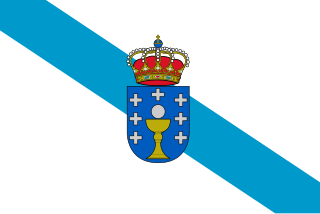
Galicia is an autonomous community of Spain and historic nationality under Spanish law. Located in the north-west of the Iberian Peninsula, it comprises the provinces of A Coruña, Lugo, Ourense and Pontevedra, being bordered by Portugal to the south, the Spanish autonomous communities of Castile and León and Asturias to the east, the Atlantic Ocean to the west, and the Cantabrian Sea to the north. It had a population of 2,718,525 in 2016 and has a total area of 29,574 km2 (11,419 sq mi). Galicia has over 1,660 km (1,030 mi) of coastline, including its offshore islands and islets, among them Cíes Islands, Ons, Sálvora, Cortegada, and—the largest and most populated—A Illa de Arousa.

In modern politics and history, a parliament is a legislative body of government. Generally, a modern parliament has three functions: representing the electorate, making laws, and overseeing the government via hearings and inquiries.
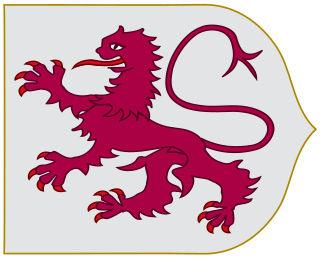
The Kingdom of León was an independent kingdom situated in the northwest region of the Iberian Peninsula. It was founded in AD 910 when the Christian princes of Asturias along the northern coast of the peninsula shifted their capital from Oviedo to the city of León. The County of Castile separated in 931, the County of Portugal separated to become the independent Kingdom of Portugal in 1139 and the eastern, inland part of León was joined to the Kingdom of Castile in 1230.

The Cortes Generales are the bicameral legislative chambers of Spain, consisting of two chambers: the Congress of Deputies and the Senate. The members of the Cortes are the representatives of the Spanish people.

The Kingdom of Navarre, originally the Kingdom of Pamplona, was a Basque-based kingdom that occupied lands on either side of the western Pyrenees, alongside the Atlantic Ocean between present-day Spain and France.

The Kingdom of Castile was a large and powerful state located on the Iberian Peninsula during the Middle Ages. Its name comes from the host of castles constructed in the region. It began in the 9th century as the County of Castile, an eastern frontier lordship of the Kingdom of León. During the 10th century its counts increased their autonomy, but it was not until 1065 that it was separated from León and became a kingdom in its own right. Between 1072 and 1157 it was again united with León, and after 1230 this union became permanent. Throughout this period the Castilian kings made extensive conquests in southern Iberia at the expense of the Islamic principalities. Castile and León, with their southern acquisitions, came to be known collectively as the Crown of Castile, a term that also came to encompass overseas expansion.

The Crown of Aragon was a composite monarchy, also nowadays referred to as a confederation of individual polities or kingdoms ruled by one king, with a personal and dynastic union of the Kingdom of Aragon and the County of Barcelona. At the height of its power in the 14th and 15th centuries, the Crown of Aragon was a thalassocracy controlling a large portion of present-day eastern Spain, parts of what is now southern France, and a Mediterranean "empire" which included the Balearic Islands, Sicily, Corsica, Sardinia, Malta, Southern Italy and parts of Greece. The component realms of the Crown were not united politically except at the level of the king, who ruled over each autonomous polity according to its own laws, raising funds under each tax structure, dealing separately with each Corts or Cortes. Put in contemporary terms, it has sometimes been considered that the different lands of the Crown of Aragon functioned more as a confederation than as a single kingdom. In this sense, the larger Crown of Aragon must not be confused with one of its constituent parts, the Kingdom of Aragon, from which it takes its name.

The Cádiz Cortes was the first national assembly to claim sovereignty in Spain. It represented the abolition of the old kingdoms. The opening session was held on 24 September 1810, in the building now known as the Real Teatro de las Cortes. It met as one body and its members represented the entire Spanish empire. The sessions of the national legislative body met in the safe haven of Cádiz during the French occupation of Spain during the Napoleonic Wars. The Cádiz Cortes were seen then, and by historians today, as a major step towards liberalism and democracy in the history of Spain. The liberal Cortes passed the Spanish Constitution of 1812, which established a constitutional monarchy and eliminated many basic institutions that privileged some groups over others.

The Crown of Castile was a medieval state in the Iberian Peninsula that formed in 1230 as a result of the third and definitive union of the crowns and, some decades later, the parliaments of the kingdoms of Castile and León upon the accession of the then Castilian king, Ferdinand III, to the vacant Leonese throne. It continued to exist as a separate entity after the personal union in 1469 of the crowns of Castile and Aragon with the marriage of the Catholic Monarchs up to the promulgation of the Nueva Planta decrees by Philip V in 1715.
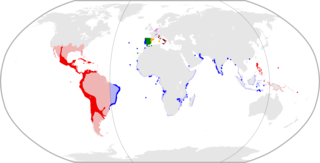
The Council of Castile, known earlier as the Royal Council, was a ruling body and key part of the domestic government of the Crown of Castile, second only to the monarch himself. It was established under Queen Isabella I in 1480 as the chief body dealing with administrative and judicial matters of the realm. With the 1516 ascension of King Charles I to the throne of both Castile and Aragon, the Royal Council came to be known as the Council of Castile because Charles was king of many dominions other than Castile, while the Council retained responsibility only over Castile.

Ferdinand II, called the Catholic, was King of Aragon from 1479 until his death. His marriage in 1469 to Isabella, the future queen of Castile, was the marital and political "cornerstone in the foundation of the Spanish monarchy." As a consequence of his marriage to Isabella I, he was de jure uxoris King of Castile as Ferdinand V from 1474 until her death in 1504. At Isabella's death the crown of Castile passed to their daughter Joanna, by the terms of their prenuptial agreement and her last will and testament. Following the death of Joanna's husband Philip I of Spain, and her alleged mental illness, Ferdinand was recognized as regent of Castile from 1508 until his own death. In 1504, after a war with France, he became King of Naples as Ferdinand III, reuniting Naples with Sicily permanently and for the first time since 1458. In 1512, he became King of Navarre by conquest. In 1506 he married Germaine of Foix of France, but Ferdinand's only son and child of that marriage died soon after birth; had the child survived, the personal union of the crowns of Aragon and Castile would have ceased.
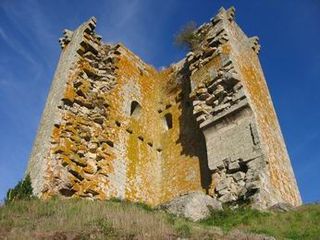
The Irmandiño revolts were two revolts that took place in 15th-century Kingdom of Galicia against attempts by the regional nobility to maintain their rights over the peasantry and the bourgeoisie. The revolts were also part of the larger phenomenon of popular revolts in late medieval Europe caused by the general economic and demographic crises in Europe during the fourteenth and fifteenth centuries. Similar rebellions broke out in the Hispanic Kingdoms, including the War of the Remences in Catalonia and the foráneo revolts in the Balearic Islands.
The Supreme Central and Governing Junta of the Kingdom formally was the Spanish organ that accumulated the executive and legislative powers during the Napoleonic occupation of Spain. It was established on 25 September 1808 following the Spanish victory at the Battle of Bailén and after the Council of Castile declared null and void the abdications of Charles IV and Ferdinand VII done at Bayonne earlier in May. It was active until 30 January 1810. It was initially formed by the representatives of the provincial juntas and first met in Aranjuez chaired by the Count of Floridablanca, with 35 members in total.
The Juntas Generales are representative assemblies in the Southern Basque Country that go back to the 14th century. The three main Juntas Generals in the Basque Country were - and are - the Juntas Generales of Biscay, the Juntas Generales of Gipuzkoa and the Juntas Generales of Álava. The equivalent in Navarre was the Cortes—or The Three States, roughly House of the Commons—to become the present-day Parliament of Navarre.

The Kingdom of Granada was a territorial jurisdiction of the Crown of Castile from the conclusion of the Reconquista in 1492 until Javier de Burgos' provincial division of Spain in 1833. This was a "kingdom" ("reino") in the second sense given by the Diccionario de la lengua española de la Real Academia Española: the Crown of Castile consisted of several such kingdoms. Its extent is detailed in Gelo del Cabildo's 1751 Respuestas Generales del Catastro de Ensenada (1750–54), which was part of the documentation of a census. Like the other kingdoms within Spain, the Kingdom of Granada was abolished by the 1833 territorial division of Spain.
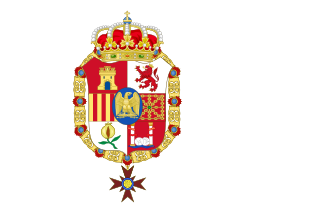
Napoleonic Spain was the part of Spain loyal to Joseph I during the Peninsular War (1808–1813) after the country was partially occupied by French forces. During this period, the country was considered a client state of the First French Empire.

In the Medieval Kingdom of Portugal, the Cortes was an assembly of representatives of the estates of the realm - the nobility, clergy and bourgeoisie. It was called and dismissed by the King of Portugal at will, at a place of his choosing. Cortes which brought all three estates together are sometimes distinguished as Cortes-Gerais, in contrast to smaller assemblies which brought only one or two estates, to negotiate a specific point relevant only to them.

The Catalan Courts or General Court of Catalonia was the policymaking and parliamentary body of the Principality of Catalonia from the 13th to the 18th century. The courts were made up of three arms or estates: the military estate which included representatives from the nobility, the ecclesiastical estate which saw representatives from the religious hierarchy and the royal estate which had representatives from the municipalities. The courts were summoned by the king who opened with a royal proclamation while the arms were in charge of legislating, always with the support of the sovereign. If the laws that were approved came from the king they received the name of "Constitutions", if they came from the Estates, "Court Chapters". If the king passed a law unilaterally it was called "Acts of Courts" and required ratification by the courts.

